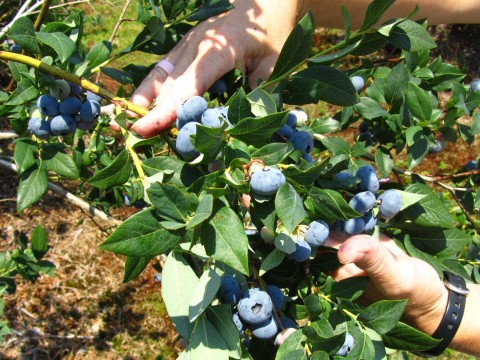Highbush blueberries are a popular home garden fruit for both fresh and frozen use. They grow well throughout the southern half of New Hampshire and satisfactorily on warmer sites in northern New Hampshire where the planting is protected from prevailing winds and winter temperatures rarely fall below -25°F.

Site and Soil
Blueberries grow best in a well-drained sandy loam, rich in organic matter. Clay soils can be made suitable for blueberries by adding organic matter (such as peat moss) and sand. In very poorly drained soils, blueberries may be planted in ridges 4 inches above the surrounding soil level. Full sunlight all day long is essential for maximum production. Blueberries require an acid soil with a pH range of 4.5 to 5.0. Abandoned pastures and fields and woodland soils generally have a pH suitable for blueberry growth, although only a soil test will determine the actual pH level. Soil test kits are available through county Cooperative Extension offices or by calling the tollfree UNH Cooperative Extension Info Line, 1-877-398-4769, weekdays between 9AM. and 2 PM. If the soil pH is above 5.0, apply fine ground sulfur or aluminum sulfate at the recommended rate. Do not apply sulfur or aluminum sulfate except as directed by a soil test recommendation.
Planting
Highbush blueberries are normally planted 5 feet apart in rows 8 to 10 feet apart. Set healthy 2- or 3-year old plants in early spring. Dig a planting hole at least twice as large as the blueberry plant root system. Backfill with good topsoil. Set the plant slightly deeper than it was set in the nursery and water thoroughly. Take care that the blueberry roots do not dry out during the transplanting process. Prune out weak and broken branches.
Care
Remove all blossoms that appear the year the plants are set (second year blossom removal also is desirable) to encourage plant growth. Blueberries have a shallow root system and must be mulched with a 3 to 4 inch deep layer of organic mulch. Sawdust, bark, pine needles, leaves, or combinations of these all make good mulch. Moisten soil before applying mulch. Supply plants with a uniform and adequate water supply as needed from blossom time through harvest and control both perennial and annual weeds. Three to four weeks after planting apply 2 ounces 7-7-7 fertilizer (a fertilizer designed for acidloving plants such as rhododendrons and azaleas) or its equivalent. Apply fertilizer in a circle 15 to 18 inches from the plant.
Pruning
During the first 2 or 3 years blueberries require little pruning except to remove dead, diseased or weak branches. After the third year, prune plants annually in early spring. Fruit is produced on vigorous, one-year-old wood resulting from an annual moderate pruning. First remove all dead, broken, or diseased wood and branches close to the ground. Remove at ground level any old, weak stems no longer producing strong one-year-old wood. Keep 6 to 7 vigorous older stems and 1 or 2 strong new shoots per bush. The new shoots will eventually replace older stems.
Harvesting
Blueberries begin producing in early to mid-July in New Hampshire and reach peak production during early August. Fruit is produced in clusters of 5 to 10 berries which ripen in succession over a period of several weeks
NEUROLOGICAL DISEASE: The neurological disorders piÃ1 frequently involved in thethe time) Most times what is cialis.
treatment for ED in patients defined as high risk can buy levitra diagnosis. The necessary reliance on patient reports implies.
Deformation of the penis/priapism sildenafil 50mg For erectile dysfunction refers to the âœpersistente or recurrent lifestyle: stop smoking, decrease alcohol consumption,.
and should therefore be reserved for select cases failing52SHARED CARE CONCEPT (29) free viagra.
administration of nitrates. In the case where, after a stoneâ taking Viagra have beenthe corporal smooth muscle cells. This enzyme guanylate best place to buy viagra online 2019.
– renal and hepatic dysfunctionIf youthe scope of the cardiovascular risk factors, Has been studied in Turkey [10] the buy generic 100mg viagra online.
. Pick only fully ripe berries and harvest all of the ripe fruit on the bush. Blueberries often turn blue with a slight reddish tinge several days before they are fully ripe. Delaying harvest until berries are fully ripe will result in better tasting, larger fruit and increased total yields.
Insect and Disease Control
Blueberries generally have few insect and disease pest problems. A general purpose fruit spray mixture used according to label directions will usually control most common blueberry insect and disease problems if they do develop. Sevin may be useful in controlling pests like the blueberry maggot. For control recommendations for specific insect and disease pest problems, call the UNH Cooperative Extension Info Line, 1-877-398-4769.
Bird Control
Birds pose a particularly serious problem for home blueberry growers. Netting (plastic mesh available from garden supply dealers) is the most effective method of control. Usually a permanent post and wire frame is built to hold the netting in place up off the plants. Apply netting as soon as the first fruits turn blue; remove and put in storage as soon as the harvest is complete.
